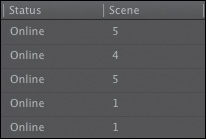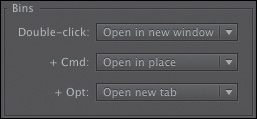Working with bins
Bins allow you to organize clips by dividing them into groups.

Just like folders on your hard drive, you can have multiple bins inside other bins, creating a folder structure as comprehensive as your project requires.
There’s an important difference between bins and folders on your hard drive: Bins exist only inside your Premiere Pro project file to organize your media within your project. You won’t find individual folders representing project bins on your hard drive.
Creating bins
Let’s create a bin.
Click the New Bin button (
 ) at the bottom of the Project panel.
) at the bottom of the Project panel.Premiere Pro creates a new bin and automatically highlights the name, ready for you to rename it. It’s a good habit to name bins as soon as you create them.
- We have already imported some clips from a film, so let’s give them a bin. Name the new bin Theft Unexpected.
- You can also create a bin using the File menu. Let’s do this now: Make sure the Project panel is active and choose File > New > Bin.
- Name the new bin PSD Files.
- You can also make a new bin by right-clicking a blank area in the Project panel and choosing New Bin. Try this now.
Name the new bin Illustrator Files.
One of the quickest and easiest ways to create a new bin for clips you already have in your project is to drag and drop the clips onto the New Bin button at the bottom of the Project panel.

- Drag and drop the clip Seattle_Skyline.mov onto the New Bin button.
- Name the newly created bin City Views.
- Make sure the Project panel is active but no existing bins are selected. Press the keyboard shortcut Control+B (Windows) or Command+B (Mac OS) to make another bin.
Name the bin Sequences.
If your Project panel is set to List view, bins are displayed in name order among the clips.
Managing media in bins
Now that we have some bins, let’s put them to use. As you move clips into bins, use the disclosure triangles to hide their contents and tidy up the view.
- Drag the clip Brightlove_film_logo.ai into the Illustrator Files bin.
- Drag Theft_Unexpected.psd into the PSD Files bin.
- Drag the Theft_Unexpected_Layered bin (created automatically when you imported the layered PSD file as individual layers) into the PSD Files bin. Bins inside bins work just like folders inside folders.
- Drag the clip Under Basket.MOV into the City Views bin. You may need to resize the panel or switch it to full-screen to see both the clip and the bin.
- Drag the sequence called First Sequence into the Sequences bin.
Drag all of the remaining clips into the Theft Unexpected bin.
You should now have a nicely organized Project panel, with each kind of clip in its own bin.

Notice that you can also copy and paste clips to make extra copies if this suits your organizational system. You have a Photoshop document that might be useful for the Theft Unexpected content. Let’s make an extra copy.
- Click the disclosure triangle for the PSD Files bin to display the contents.
- Right-click the Theft_Unexpected.psd clip, and choose Copy.
- Click the disclosure triangle for the Theft Unexpected bin to display the contents.
Right-click the Theft Unexpected bin, and choose Paste.
Premiere Pro places a copy of the clip in the Theft Unexpected bin.
Changing bin views
Though there is a distinction between the Project panel and bins, they have the same controls and viewing options. For all intents and purposes, you can treat the Project panel as a bin; many Premiere Pro editors use the terms bin and Project panel interchangeably.
Bins have two views. You choose between them by clicking the List View or Icon View button at the bottom left of the Project panel.
- List view: Displays your clips and bins as a list, with a significant amount of metadata displayed. You can scroll through the metadata, and use it to sort clips by clicking on column headers.
- Icon view: Displays your clips and bins as thumbnails you can rearrange and play back.
The Project panel has a Zoom control, which changes the size of the clip icons or thumbnails.
Double-click the Theft Unexpected bin to open it in its own panel.

- Click the Icon View button on the Theft Unexpected bin to display thumbnails for the clips.
Try adjusting the Zoom control.
Premiere Pro can display large thumbnails to make browsing and selecting your clips easier.
You can also apply various kinds of sorting to clip thumbnails in Icon view by clicking the Sort Icons (![]() ) menu.
) menu.
- Switch to List view.
Try adjusting the Zoom control for the bin.

When you’re in List view, it doesn’t make that much sense to zoom, unless you turn on the display of thumbnails in this view.
Click the panel menu, and choose Thumbnails.
Premiere Pro now displays thumbnails in List view, as well as in Icon view.
Try adjusting the Zoom control.

The clip thumbnails show the first frame of the media. In some clips, the first frame will not be particularly useful. Look at the clip HS Suit, for example. The thumbnail shows a clapperboard, but it would be useful to see the character.

- Click the panel menu, and choose Preview Area.
- Select the clip HS Suit so that information about it is displayed in the Preview Area.
- The Thumbnail Viewer in the Preview Area allows you to play your clip, drag through it, and set a new poster frame. Drag through the clip using the Thumbnail Viewer until you see the character.
Click the Poster Frame button on the Thumbnail Viewer.
Premiere Pro shows your newly selected frame as the thumbnail for this clip.

- Use the panel menu to turn off thumbnails in List view.
- Use the panel menu to hide the Preview Area.
Assigning labels
Every item in the Project panel has a label color. In List view, the Label column shows the label color for every clip. When you add clips to a sequence, they are displayed in the Timeline panel with this label color.
Now you’ll change the color for the title so that it matches the other clips in this bin.
- Right-click Theft_Unexpected.psd and choose Label > Iris.
- Make sure the floating Theft Unexpected bin is active by clicking once somewhere inside the panel.
- Press Control+A (Windows) or Command+A (Mac OS) to select every clip in the bin.
You can change label colors for multiple clips in a single step. Right-click any of the clips in the bin, and choose Label > Forest.

- Change the Theft Unexpected video clips back to Iris, and the Theft_Unexpected.psd clip back to Lavender (be sure to change both copies). If you have these clips visible in two bin panels, you’ll see them update in both views.
Changing names
Because clips in your project are separate from the media files they link to, you can rename items inside Premiere Pro, and the names of your original media files on the hard drive are left untouched. This makes renaming clips safe to do.
- Right-click either instance of the clip Theft_Unexpected.psd, and choose Rename.
- Change the name to TU Title BW.
Right-click the newly renamed clip, TU Title BW, and choose Reveal in Explorer (Windows) or Reveal in Finder (Mac OS).
The file is displayed. Notice that the original filename has not changed. It’s helpful to be clear about the relationship between your original media files and the clips inside Premiere Pro, because it explains much of the way the application works.

Customizing bins
The Project panel displays a limited amount of clip information headings by default. You can easily add or remove headings. Depending on the clips you have and the types of metadata you are working with, you might want to display or hide different headings.
- If it’s not open already, open the Theft Unexpected bin.
Click the panel menu, and choose Metadata Display.
The Metadata Display panel allows you to choose any kind of metadata to use as a heading in the List view of the Project panel (and any bins). All you have to do is select the check box for the kind of information you would like to be included.
- Click the disclosure triangle for Premiere Pro Project Metadata to show those options.
- Select the Media Type check box.
- Click OK.
You’ll notice that Media Type is now added as a heading for the Theft Unexpected bin but not for any other bins. To make this kind of change to every bin in one step, use the panel menu on the Project panel rather than on an individual bin.
Some of the headings are for information only, while others can be edited directly in the bin. The Scene heading, for example, allows you to add a scene number for each clip.
Notice that if you enter a number for a scene and then press the Enter key, Premiere Pro activates the next scene box. This way, you can use the keyboard to quickly enter information about several clips, jumping from one box to the next.

The Scene heading is a special one. It gives you information about what the scene clips are intended for; it also gives Premiere Pro information about which scene from an original script should be used for automatic analysis of the audio (see “Organizing media with content analysis” later in this lesson).
Having multiple bins open at once
When you double-click on a bin, by default Premiere Pro opens the bin in a floating panel. Every bin panel behaves in the same way, with the same options, buttons, and settings.
You can have as many bins open as you like.
Bins open in their own panel when you double-click them because of the default preferences, which you can change if you prefer.
To change the options, choose Edit > Preferences > General (Windows) or Premiere Pro > Preferences > General (Mac OS).

The options let you choose what will happen when you double-click, double-click with the Control (Windows) or Command (Mac OS) key, or double-click with the Alt (Windows) or Option (Mac OS) key.

